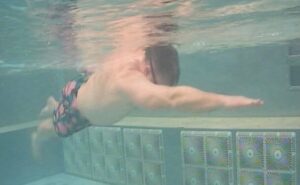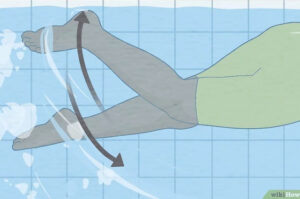 Swimming freestyle correctly is a complex task. Movement in the water is a big part of the challenge. All body actions are connected: what’s happening in your feet is connected to what’s happening in your hands. The more efficiently your body moves, the faster you go. Sinking legs and hips increase drag making you work harder to move forward. Maybe you’ve been told you need to work on better body position. This is a fundamental element to better swimming. But how do you accomplish this?
Swimming freestyle correctly is a complex task. Movement in the water is a big part of the challenge. All body actions are connected: what’s happening in your feet is connected to what’s happening in your hands. The more efficiently your body moves, the faster you go. Sinking legs and hips increase drag making you work harder to move forward. Maybe you’ve been told you need to work on better body position. This is a fundamental element to better swimming. But how do you accomplish this?
Short cuts to better body position
The easy way to improve your body position in the water is to use buoyancy equipment: pull buoy, buoyancy shorts and wetsuits. Any of these will quickly improve your body position by decreasing the drag of your legs. As a coach, I recommend these tools all the time. Each has a time and place and can be very, very helpful especially if your body is truly a “sinker”. But is it really? Often, I work with swimmers and triathletes who seem to have a terrible time with their body position and with time and work on specific techniques, they improve.
Breathing and the survival mechanism
Breathing is fundamental to life and if we struggle to breathe in the water, we struggle to swim. I once worked with a budding pro triathlete who wasn’t breathing properly. It’s very common. While swimming, we can’t breathe whenever we want. Breathing and body position are often connected. When you’re in survival mode, you’ll hit a ceiling with your swimming.
Breathe deeply, filling and emptying your lungs as quickly as possible. Your lungs act like a buoy. Get a full, strong exhale when your face is in the water as this drives the inhale. You can’t get more air in when your lungs are already full. If you struggle with getting enough air, focus on forceful, conscious breathing until it becomes an easy habit.
Head/chest position: the teeter totter
There is a teeter totter relationship between your head and your feet. If you can press your chest flatter in the water, often your hips and legs will lift. Notice I said press your chest, not your head. Think of your chest and head as one connected unit. Too often, pressing your head creates a “burying” of your head, then a “bobbing” motion to breathe…. Head too low, lift head too high to breathe, repeat. Keep the crown of your head on the surface when you’re not breathing.
Rotate head and body to breathe
Basic breathing is best accomplished by rotating your face out of the water as you rotate your body. Too often, swimmers will push the opposite arm down on the water to help lift the head out to breathe. This means more bobbing and no real propulsion during the breath cycle – survival mode.
Instead, have your opposite arm extend and gently press on your shoulder, as you then rotate to breathe. Example: If I’m breathing to my right, I extend my left arm and shoulder, then press gently on my shoulder as I rotate my head and body to breathe. Just turning, not lifting or pushing your arm down. Ideally, you want to keep one goggle in the water, but if you struggle to inhale air, not water, rotate more to breathe.
What’s up with the kick? Does it help with body position?
In simple terms, the kick is comprised of two basic components: the up kick and the down kick. Strength and movement is generated from the hips and core. The down kick is pressing the top of your foot and front of your leg down on the water initiated with a slight bend at the knee. The up kick is bottom of the foot, back of the leg – straight knee, pushing up on the water from the glutes. No bending at the hips. The leg moves more like a pendulum at the hips.
That’s right, more up kick. By focusing on the up kick, this will help lift your sinking legs and hips and does not need to take a lot of extra energy.
What’s the lowdown on the kick in triathlon swimming?
 How much kick is enough? Using the large muscles in your legs does require more oxygen and more energy to move, hence impacting your overall energy level. But, if you actually train your kick, you will improve your swim. If you don’t have an efficient kick, you do not have an efficient freestyle. Think of your kick as a tool in your tool box. Take it out when you want to use it (swimming fast intervals), put it away when you want to conserve energy (long aerobic efforts). Use it or do not; this is your choice. But train it, so you do have a choice. Keep kicking when you breathe to support the breath cycle. Leg splitting or inefficient movement contribute to sinking legs and loss of momentum.
How much kick is enough? Using the large muscles in your legs does require more oxygen and more energy to move, hence impacting your overall energy level. But, if you actually train your kick, you will improve your swim. If you don’t have an efficient kick, you do not have an efficient freestyle. Think of your kick as a tool in your tool box. Take it out when you want to use it (swimming fast intervals), put it away when you want to conserve energy (long aerobic efforts). Use it or do not; this is your choice. But train it, so you do have a choice. Keep kicking when you breathe to support the breath cycle. Leg splitting or inefficient movement contribute to sinking legs and loss of momentum.
Finally, engage your core when swimming. This is often forgotten, but the core is a key component connecting the legs to the arms. As your breathing and body position improve, your efficiency and speed will increase exponentially.
REFERENCES
Shaeff, Andrew. My feet and hips sink when I swim. How do I fix it? Triathlete Magazine: Jul 13, 2023.